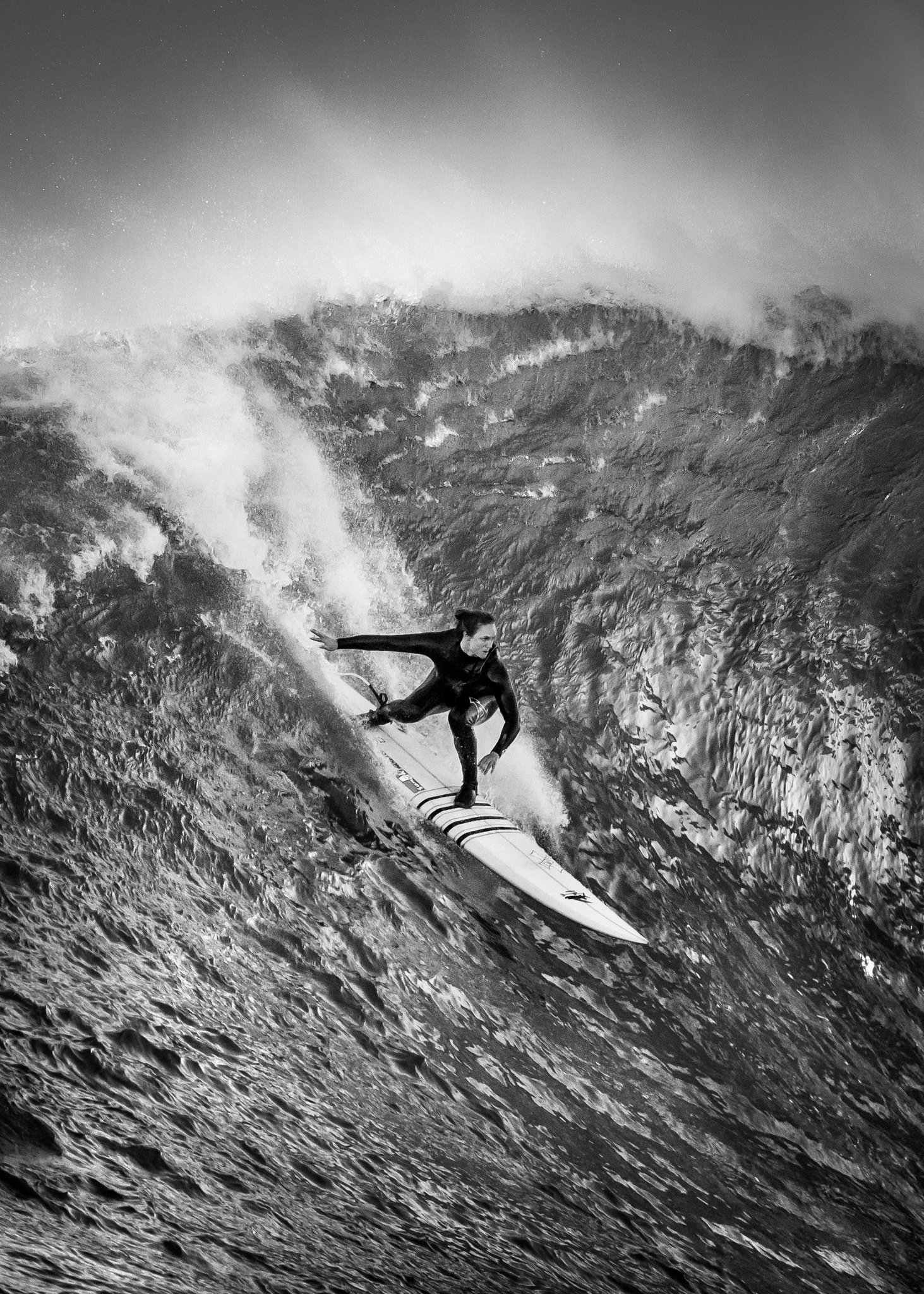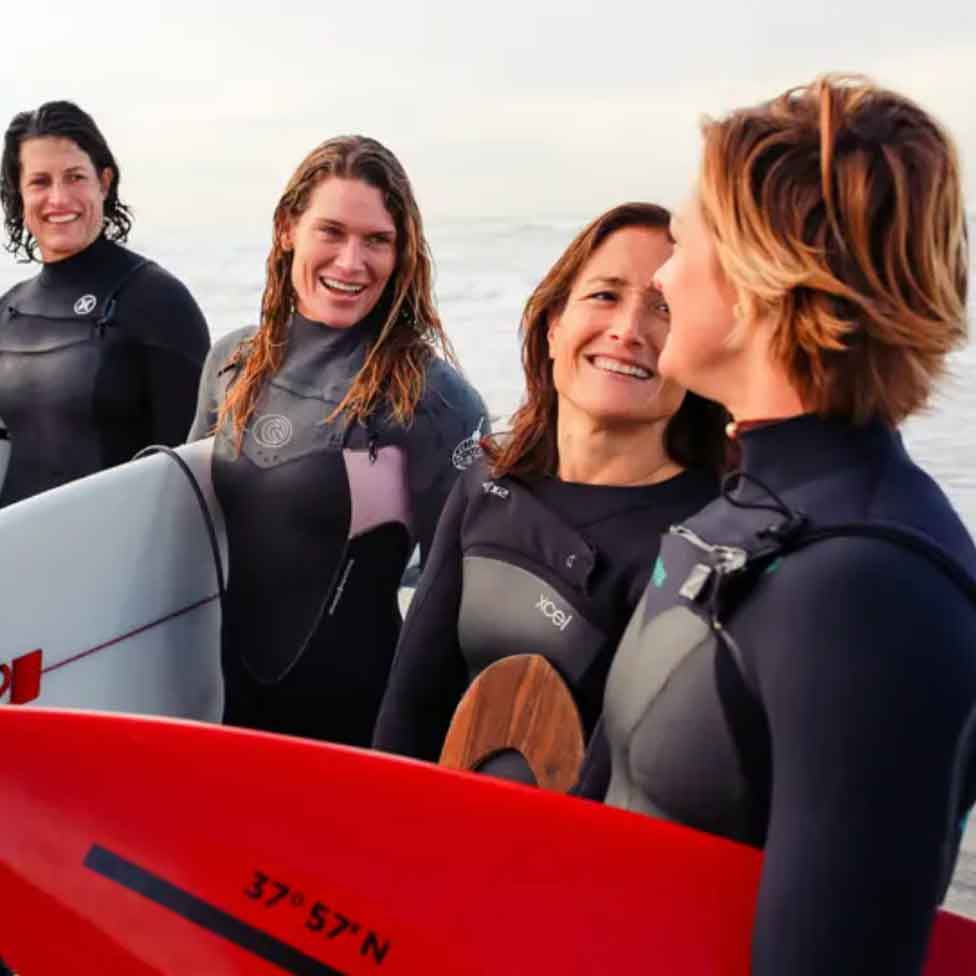One sunny morning in January 2018, on a white boat in the blue sea off the Hawaiian island Maui, Bianca Valenti and Keala Kennelly sat on a beanbag listening to “German Sparkle Party,” a song by the Something Experience, and waiting for the right moment to surf 50-foot waves. Valenti, who is 33 and a muscular 5-foot-5, with a small, square jaw and friendly brown eyes, lives in San Francisco and is the best female big-wave surfer on the United States mainland. Kennelly, 40 and a slight 5-foot-6 with spiky peroxided hair, lives on Oahu in Hawaii and is the best female big-wave surfer on Earth.
The waves that day, at a surf spot called Peahi or more commonly known as Jaws, were the biggest in recent memory. They were too big, really, with plenty in the ideal range of 40 to 50 feet on the face but others in the borderline-impossible range of 70 to 80. A strong wind was also creating bumps on the ocean surface, like boulders on a bad dirt road. Kennelly had already ridden a 40-footer that day, paddling her surfboard to catch a wave at its tallest point, hopping to her feet and soaring down the enormous blue face, then turning hard onto the unbroken wall and riding fast in front of the curl until the wave petered out. It wasn’t the kind of ride that attracts endorsement deals or wins the big-wave equivalent of an Oscar at the annual World Surf League Big Wave Awards. The wave did not qualify as mind-blowingly huge, and Kennelly did not get barreled, a.k.a. tubed, the ne plus ultra of the sport, by riding inside the whirling cylinder created when the lip of the wave curls over and forms a tunnel before collapsing. But that day Kennelly was trying to avoid hospitalization by restraining her native impulse toward extreme risk-taking.
Valenti was less comfortable at Jaws. She had surfed smaller waves there many times but waves of this size only a few, and on this particular afternoon, she had yet to get in the water. Jaws is one of the world’s two most important big-wave breaks; the other is Maverick’s, a half-hour south of San Francisco, which Valenti surfs regularly. Valenti knew that getting barreled at Jaws would be a career-defining moment for her. And she openly confessed that it was her life’s dream. Back home, she jumps off 10-meter diving platforms to overcome fear of long falls and practices the breathing techniques of an eccentric Dutch athlete and endurance guru, Wim Hof, who is known as the Iceman, in hopes of better surviving long underwater hold-downs after wipeouts, when turbulent water prevents a surfer from rising to get air. Valenti also follows the guidance of a Stanford neuroscientist and her personal sports psychologist to conjure spirit animals appropriate to specific surf conditions: killer bee, spider monkey and, that day at Jaws, a character she called Malolo bull kitty, a cross between a flying fish, a bull and, well, a kitty.
Valenti took in the scene: 16 other boats crowded with photographers, 12 men on Jet Skis racing in and out of the danger zone to rescue surfers after wipeouts and, among the waves, 50-plus men from what might be called the international big-wave jet set, an almost exclusively male community of pros from Europe, Africa, Australia, Hawaii and California. Valenti watched these men do what contemporary big-wave pros must to succeed — deliberately ride the most dangerous and violent portions of the day’s biggest waves — displaying astonishing skill and bravery, but also losing control and cartwheeling down heaving blue mountainsides, shattering $1,500 surfboards and being pushed to the bottom of the sea and requiring rescue.
It was already afternoon when Valenti decided she had to get in the water. She felt a burden to prove that female big-wave surfers can keep up with men — more so because she helped found, in 2016, the Committee for Equity in Women’s Surfing, an activist group that started with the modest ambition of getting women invited to big-wave contests, from which they had always been excluded, and grew unexpectedly into a reckoning for the global sport of competitive surfing.
Valenti changed into the standard big-wave outfit: a short-sleeve wet suit, a black neoprene vest bulky with buoyant padding and a second vest bristling with pull tabs. The tabs were connected to cartridges of compressed gas that could, if necessary, fill air bladders and float a surfer up from the deep. She dropped her 9-foot-6 pink surfboard into the water, splashed down after it and paddled off to join the men. Nauseated with excitement and trying to maintain what she calls “the patience of a Zen Buddhist monk,” Valenti spent the next two hours paddling up and over gigantic waves, waiting for one that she felt confident trying to ride.
A man on a Jet Ski told Valenti that her boat captain wanted to leave. Valenti reminded herself that she felt great and strong and ready. Then a wave appeared out at sea. Imagine standing on a sidewalk in front of a two-story house. Now picture a three-story house next door. Stack the first house on top of the second and extend this five-story colossus 200 yards to the right and left, a translucent aquamarine cliff speeding toward you. If Valenti froze in fear and did nothing, the cobalt wave face would suck concave into a gaping mouth with an upper lip flying forward to land on her with the impact of a commercial fishing vessel dropped out of the sky.

Paige Alms surfing at Maverick’s in December. Dina Litovsky/Redux, for The New York Times
Valenti paddled toward the wave to maintain the option of paddling up and over before it broke. Then she made a snap transition to what she calls “one million percent focus.” Valenti sat bolt upright, weighted the tail of her board and rotated 180 degrees toward shore. Paddling furiously now — “beast-mode-ing, sprinting,” she says — Valenti felt herself being pulled backward up the wave face. Prone and still paddling, she was lifted to the height of a second-story window, then a third-story window, then a fourth. She hopped to standing as the wave face steepened past vertical, and her mind went silent. Valenti and her board fell 15 feet through the air. She landed partway down the wave, accelerated off a bump on the surface and airdropped another 20 feet until she landed at the wave’s base. Astonished to find herself upright, she lost balance. Tumbling into the water, Valenti was violently pulled skyward into airborne flipping cartwheels. She yanked a tab to inflate her vest and crossed her arms to grab her own shoulders — because, she says, “the most common injury is to have your arms ripped out of your sockets.” She hit the water a second time and was drawn right back up and over that wave’s curling apex and down again through 30 feet of air and 30 feet of thrashing water. Her vest brought her to the surface just in time to be buried by a second huge wave.
A Jet Ski driver found Valenti bobbing dazed among rafts of white sea foam. Back at the boat, she climbed aboard, exhausted but full of the feeling she always gets from the instant she takes off on a big one — “peacefulness again,” as she puts it, “from anxiety to this feeling of: This is where I’m meant to be.”
Big-wave surfing originated in Hawaii in the 1940s, and by the late 1950s, it was synonymous with a break called Waimea Bay, on Oahu’s North Shore, and also with courageous masculinity. There were exceptions. A 15-year-old girl named Linda Benson rode a wave with an estimated 20-foot face at Waimea in 1959, and Margo Oberg, widely recognized as the first female professional surfer, also rode big surf at nearby Sunset Beach in the 1970s. Still, the sport was dominated by outsize male personalities like Buzzy Trent, author of an infamous article titled “Big Waves Are Masculine, Women Feminine,” in the November 1963 issue of Surf Guide magazine. “There’s nothing more beautiful than a well-shaped girl riding a six-foot wave with the wind blowing through her hair,” Trent wrote, “but one thing I can’t stand is girls riding (or attempting to ride) big waves.”
Please continue reading here.






